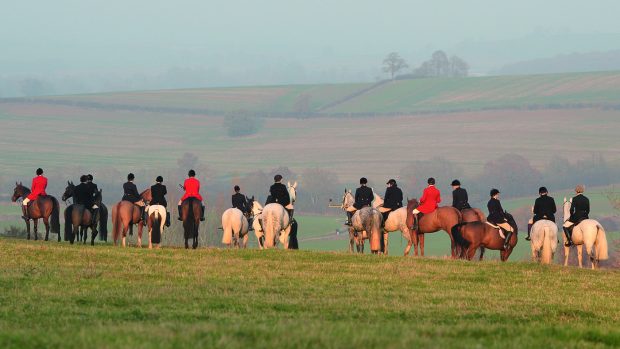What exactly is drag hunting?
A runner is used to lay a scent about 20 minutes in advance of the hunt. The days when the scent was laid with aniseed are long gone. Nowadays a chemical crystal, mixed with water and oil, is used. The runner simply dips a cloth in the scent mixture and trails it along the ground behind him. The scent, repulsive to humans, is irresistible to hounds though bloodhounds follow the human scent of the runner.
What is the difference between drag hunts that use Foxhounds and those that use Bloodhounds?
Drag hunts use a variety of hounds, including Foxhounds (a distinct breed) and Bloodhounds. Bloodhounds track a human runner, while other hounds follow a chemical scent. Aficionados say Foxhounds may be a little faster although the sight of a pack of bloodhounds in full cry is one not to be missed.
Who is in charge during a drag hunt?
There is a field master who leads the riders, and a huntsman and several whippers-in who are in control of the hounds. Some hunt staff wear traditional red coats, while others have developed their own uniforms.
Who is drag hunting suitable for?
Drag hunting is all about jumping, so if you are a novice, you will be out of your depth. Young children are not encouraged for the same reason (although some hunts do have special Christmas childrens days). However, there is no lower age limit, and if a child or teenager is capable of safely handling a sharp gallop and some cross-country jumping, they will be welcomed. Some days are more strenuous than others, however, so its worth ringing the hunt secretary to decide on a day that suits your ability.
How many hounds are there?
The Staff College and RMAS Drag Hunt uses eight couple (pairs); other drag hunts have up to 15. The packs are smaller than those used for fox hunting, which usually use 17 couple.
How are the hounds trained to follow the scent?
Its in the dogs nature to pick up and follow a scent, and it takes a hound only a day or so to get the idea.
What happens if the dogs pick up the scent of a fox or deer?
The whippers-in must stop them giving chase.
What sort of horse do you need?
Most drag hunters have their own horses, although some hunts may be able to put you in touch with riding schools that can hire you a mount. Horses and riders must be comfortable jumping fences of up to around 4ft. Although the field master will warn you about compulsory fences before each line, and give you the opportunity to sit them out, it defeats the object of the hunt to go through a full day without jumping anything.
How is a drag hunting day usually structured?
The day is divided into three or four lines. The hunt meets and then hacks to the start of the first line. On the signal of the master, the hounds are unleashed. Once they are moving, the hunt follows along a prearranged course, with built fences, for up to two miles. At the end of the line there is a pause to allow the riders to retrench, followed by a short hack to the start of the next line. Some people liken it to taking part in three or four hunter trials in an afternoon.
What drag hunting etiquette should I know about?
First and foremost: stay behind the field master. Overtaking him is a serious offence, and could put hounds in danger. Otherwise, keep out of the way of your fellow riders, behave courteously, and if your horse refuses a fence, get out of the way fast to let others take their turn. If your horse tends to kick, you must tie a red ribbon in its tail and give others a wide berth. If it is a novice and you dont know how it will react to the hunt, tie a green ribbon in its tail.
How much does it cost?
The cost varies between hunts. Most will allow you to attend for a single day at a cost of around £40. A full annual subscription costs around £360 (this allows you to hunt each weekend plus at occasional midweek meets). There is a nominal cap for each meet, usually around £5, to help with the cost of building fences. In general drag hunting is cheaper than fox hunting, for which annual subscriptions are usually around £1,000.
Why do farmers allow drag hunts on their land?
Drag hunting offers no pest-control service to farmers, and they are not paid for the use of their land. However, many drag hunts have been hunting in the area for generations, so relations are warm between them and hunt staff, and most farmers are happy to play host. The hunt builds and repairs its own jumps, liaises closely with farmers when planning its seasons, and expects its riders to behave scrupulously at all times.
Who goes drag hunting?
All sorts of people. From computer experts and company directors, to mechanics and landscape gardeners, there is a huge mixture. Ages range from young teenagers to sixty-somethings, and the split between men and women tends to be quite evenly matched.
What about foot followers?
Drag hunts do attract foot followers, and may designate a field master to make sure they get to the best vantage points on each line. There are not as many as on a fox hunt.
How many drag hunts are there in the UK?
Around 15 packs using foxhounds, with the same number of bloodhound packs. For details of hunts in your area, visit: www.draghunting.org.uk
|




